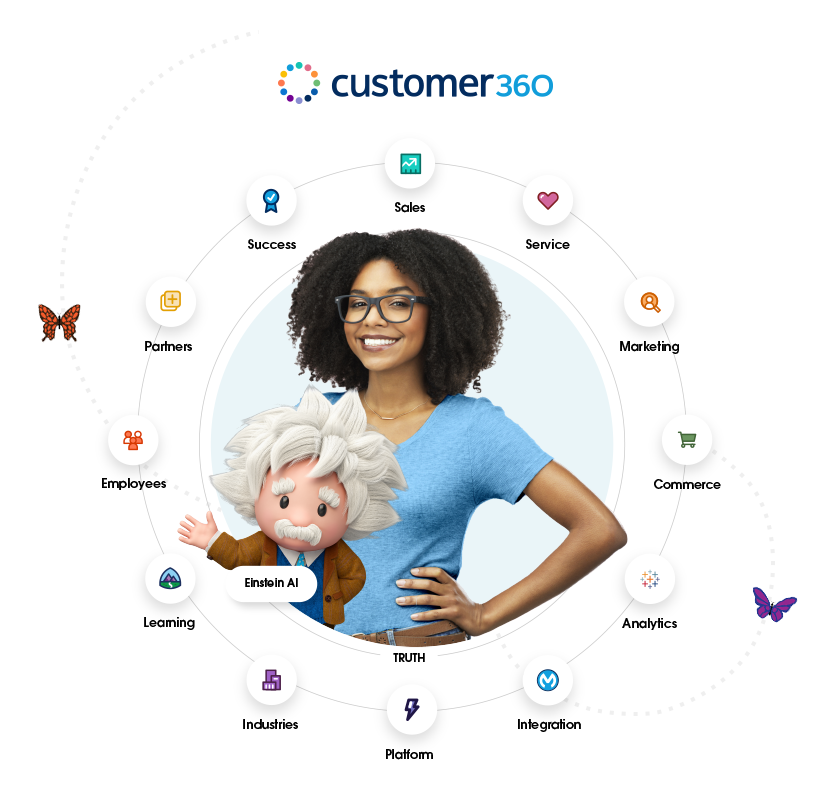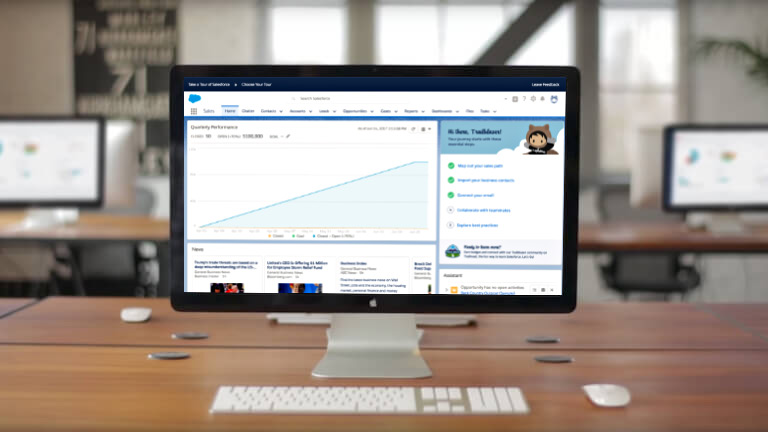The 6 Greatest Benefits of CRM Platforms to Know

Read on to learn how customer relationship management solutions create a more customer-centered organization.
Customer-centric experiences continue to define every moment in business this year, but what’s rarely discussed is what makes this shift possible for brands. To be truly customer-centric, you have to know your customers preferences and the context in which they engage with your organization. The advantages of CRM software are crystal clear: It keeps all historical data in one place, making it easier to manage customer relationships. And thankfully, the advantages of CRM have multiplied to bring multiple departments together and empower more connected teams with the same data.
This is the magic that fuels a customer-centric experience.
Today’s CRM tools are supercharged with integrations that foster collaboration and accessible data — all under one roof. The right tool should help companies target different audiences, design smart automations based on an individual lead or customer’s activity, proactively work with contacts and manage relationships. More importantly, every department can now deliver consistent, personalized interactions in the best interest of customers.
While features vary by department or industry, six advantages of CRM platforms that enable customer-centric experiences are:
A single view of the customer for cross-functional insight and reporting.
Dashboards that visually showcase data in action.
Customer-centric automation.
Proactive service.
Optimized processes.
Simplified collaboration.
1. Cross-functional insights and reporting.
Data is a necessary part of growing business in a digital-first economy, and it’s available from a number of resources: social media, Google Analytics, business software, apps, and CRM technology. It’s not useful, however, until it’s sorted, cleaned, analyzed, and made actionable for multiple teams, who all have a single, shared view of a customer and all the customer’s information.
For example, companies of all sizes use social media and rely on metrics from those platforms. Google Analytics is an important tool many business owners use, at least minimally, to monitor their website traffic. However, you’ll quickly learn in exporting Excel files that the tools alone don’t provide recommendations. Additionally, marketing analytics often don’t translate across other departments.
A CRM system can consolidate a comprehensive analysis of your customers’ online (to sometimes offline) activity to paint a holistic picture of their needs. When your company is designed to maintain clean data this way, you can use your CRM platform to collate, tabulate, and customize data in a report for unique department needs. The key differentiator here is all reporting centers around the customer needs, ultimately enabling your teams to make decisions keeping them front and center.

Empowering teams with a single, unified view of the customer is one of the biggest benefits of a CRM system, and it trickles down to other advantages that become available once you have this usable data. You can also run reports to see where your opportunities are, how well you’re interacting with leads and customers, trends in your sales and customer service efforts, and more. This informs every experience you deliver to your customers from email marketing to what online features you make available to them.
You can run those reports with any number of parameters. It’s common to categorize the consumers in your CRM as being in one of three different stages in the sales funnel: leads, opportunities, or sales. Historically, marketing works with leads, sales works with opportunities, and customer service works with sales, though there is overlap. Customer-centric organizations must work to help departments fully understand and embrace the varying needs across all consumers.
Leads — These are consumers that have filled out a form or otherwise expressed interest in your company. They may be high-quality, prospective customers, but you won’t know until they continue on the customer journey. Reports, especially those with insights driven by artificial intelligence, help CRM users like marketers and sales teams know how to work with leads to convert them to opportunities.
Opportunities — Leads who, at some point, make their way further down your sales funnel and are close to purchasing become opportunities. For example, maybe they spoke to someone on your sales team and asked for a quote, or perhaps they put an item in their shopping cart on your ecommerce site. A person’s location in your sales funnel is not something that Google Analytics or social media platforms can show you, but reports from your CRM platform can. These reports can also help you see which ads and marketing messaging are most successful at guiding leads down the funnel to opportunities, and then opportunities down to sales.
Sales — Once a person converts and becomes a customer, that doesn’t mean you’re done gathering and analyzing data. The data you collect prior to the customer’s purchase, the additional data you collect on their habits after purchase, and the information you glean from the reports you run on that data will make sure you understand those who purchase your products and services so you can continue to serve them.
Integrated CRM systems can do more than tell you which ad a lead came from. They can show you exactly what a person clicks when you send them an email marketing message, how many times they open an email, how often they have conversations with your sales team, what they need when they contact customer service, and more.
Comprehensive reports are one of the most valuable benefits of CRM platforms, especially when they’re enhanced by AI. Actionable data allows you to more effectively communicate with your current audience while also making it easier to reach out to those who have shown interest in the past. These reports guide your decision-making process and are invaluable. To keep an eye on absolutely current statistics in order to make minute-by-minute or daily decisions, your company needs data visualizations at its beck and call. This is where another one of the benefits of CRM comes in: dashboards.
2. Actionable data dashboards.
Using spreadsheets or disconnected systems to manage your customer relationships and data means inputting or importing data manually, figuring out what’s important, lacking historical context or the full picture of a customer relationship to derive proper insights, and then trying to create a graphical way to present this data. CRM does most of this for you. Once you’ve invested in the platform, you can take advantage of another CRM benefit, the dashboard. You can set up a customized dashboard for every individual to help translate insights into action.
For example, a director of marketing would be most interested in email marketing metrics, specifically the click-through rates of each campaign. They can set up a dashboard that immediately displays how many people a particular email was sent to, how many people opened it, what the click-through rate is, and more. A director of sales, however, would want to know how many calls are made per hour, and how many of those calls resulted in positive action, such as a future meeting or demo. Highlighting specific metrics can help illustrate a story of patterned customer behaviors such as which industry results in positive next steps. Dashboards let users quickly see the data that’s most important to their workflows without having to dig, sift, sort, or run a report.
3. Customer-centric automation.
Because you are continually capturing data about and insights into your audience, market, and industry, you can create more relevant, personalized messaging and outreach that’s tailored to the unique needs of each customer. This is the advantage of dynamic content and automated messaging: You can put people who have an important similarity — for example, an interest in a niche product — into different drip campaigns.
This capability is a benefit of CRM that lets you set up a series of automated emails that speak to that audience specifically and are triggered by specific actions. Drip campaigns can be used throughout the sales funnel.
For example, on a tour company website, if someone builds a custom itinerary for a trip to Thailand, instead of sending them generic emails about travel, you can start them on a drip campaign for people who create custom itineraries for Southeast Asia. Automation also allows you to take people out of a drip campaign at any time based on their actions. If, for example, the person who was interested in a trip to Thailand finally books the itinerary, your platform will automatically remove the person from that particular drip campaign to avoid redundant emails and confusion.
4. Proactive customer interactions.
In the same way that the data in your CRM platform can help automate more personalized outreach throughout the marketing funnel, it can improve a sales team’s outreach efforts or customer service’s ability to help manage customer relationships. If a sales team has the knowledge of what interests a particular customer most, they or a support representative can meet the customer’s needs and solve problems more proactively.
This is a major advantage for a customer service team. With relevant data available in their dashboards and in cases, there’s no need to dig for information, so a rep can get right down to what matters. It saves everyone time and makes your potential and current customers feel important when sales and customer service are proactive and knowledgeable — plus, it can improve your bottom line through higher customer satisfaction and reduced time to resolution.
5. Optimized processes.
Automation is an advantage CRM platforms offer users, and it can be seen throughout the company. Three examples include:
Cutting the time it takes to email and nurture leads with drip campaigns
Consistent, customer-centric interactions across marketing, sales, commerce, and service through personalized automations.
Scoring leads using custom parameters you set or with built-in AI, so your teams can better prioritize which marketing qualified leads, or MQL, can transition to sales qualified leads, or SQL
Marketing can spend more time creating campaigns that resonate with its audience, analyzing data, and testing different strategies based on analytics. Sales can focus on selling the right product or service to customers. Commerce can create more personalized buying experiences that translate to revenue growth. Customer service agents can dedicate their time to working with customers who have questions, problems, or more complex needs. Ultimately, an efficient company can better serve its customers — that’s the greatest benefit of CRM software.
6. Simplified collaboration.
Your CRM serves as a record of conversations, interactions, needs, notes, and contact information — an incredible advantage to winning customer-centric experiences. And if it’s cloud-based, it’s always up to date, and your teammates can easily access records from anywhere. Additionally, some CRM platforms have built-in collaboration and communication tools that allow many people to work on one file simultaneously or follow the progress of a document, such as a sales quote allowing faster response times to customer requests.
Everyone who has access to your CRM can work together through this shared record. For example, when a salesperson speaks with a customer and learns more about them, they can fill in certain fields in that person’s record or make notes on their file. This helps make sure the rest of the team is working with the latest details and to the best of their ability. Marketing, sales, commerce, and customer service work together seamlessly instead of worrying about siloed information.
The Takeaway
All team members can gather insights and data and work together to provide exceptional customer-centric experiences. Data organized and presented by a CRM platform leads to a better understanding of customers. This leads to better messaging and outreach, much of which can be done with automation, which helps you offer better, more efficient customer service. Furthermore, your teams can collaborate more easily and reduce siloes.
Of all the benefits of CRM software, using data and technology to power a more efficient company is one of the biggest. This helps you manage customer relationships more effectively, leading to better business.
Keep Learning

Free Trial
What is Salesforce CRM? Try it free and see how it can help you grow your business.
Getting Started with CRM
Overview
What is CRM?
Chapter 1
Chapter 2
Chapter 3
Questions? We’ll put you on the right path.




